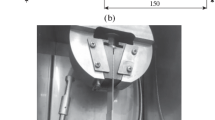Summary
Butt-joint strength was measured on a series of epoxy resin-to-chrome plate adhesive bonds comparing the effect of curing the resin with different stoichiometric proportions of cross-linking agent. Adhesive bonds prepared with low stoichiometric proportions of curing agent consistently exhibited apparent adhesional failure. Adhesive bonds prepared with higher stoichiometric proportions of curing agent consistently yielded apparent cohesive failure. A point of direct correspondence was noted between trends of bulk elastic properties in the cured adhesive and joint strength with curing agent concentration. In the case of adhesive bond compositions which consistently yielded apparent adhesional failure an unexpected correlation was noted between butt-joint strength and the bulk tensile strength of the adhesive. In the more detailed evaluation of joint fracture surfaces by means of radiotracer techniques which followed, molecularly thin layers of cross-linked radioactive adhesive were anchored at the metal substrate surface prior to application of the non-radioactive bulk layer of adhesive and formation of the adhesive bond. Autoradiographs of the resulting radioactive joint fractures indicated large areas of the adherend surfaces which were completely free of adhesive in the case of apparent adhesional joint failures. Sufficiently thick pretreatments of the adherend bonding surface with cross-linked adhesive were found to prevent apparent adhesional failure, but produced no measurable increase in joint strength. It was found that all the preceding observations and correlations could be interpreted according to a proposed mechanism of joint failure in which it is assumed that the joint failure crack always originates in a bulk region of the adhesive.
Zusammenfassung
Die Stärke von Endklebeverbindungen wurde an einer Reihe von Epoxidharzen an Chromplatten mit verschiedenen stöchiometrischen Proportionen des Härters gemessen. Klebeverbindungen mit einem niedrigen stöchiometrischen Verhältnis des Härtemittels versagten augenscheinlich durch Mangel an Adhäsion. Klebeverbindungen, mit einem hohen stöchiometrischen Verhältnis des Härtemittels versagten augenscheinlich durch Mangel an Kohäsion. Ein Abhängigkeitsverhältnis zwischen den elastischen Eigenschaften der Klebemasse, der Klebestärke sowie der Konzentration des Härtemittels wurde festgestellt.
In den Kompositionen, die Mangel an Adhäsion zeigten, wurde die überraschende Feststellung gemacht, daß die Stärke der Endklebeverbindung und die Stärke des Klebemittels selbst übereinstimmten.
Darauf wurde eine genauere Untersuchung der Brüche unternommen. Eine sehr dünne Schicht Klebemittel, das radioaktive Substanzen enthielt, wurde auf das Metall aufgetragen. Darauf folgte der normale Auftrag des gesamten Klebemittels ohne radioaktiven Zusatz. Wenn darauf der Bruch, der durch Adhäsionsversagen hervorgerufen war, untersucht wurde, konnte festgestellt werden, daß die Oberflächen, die sich vom Klebemittel gelöst hatten, keine radioaktiven Spuren mehr enthielten. Wurde eine dickere Schicht des radioaktiven Klebemittels auf das Metall aufgetragen, so wurde kein Versagen der Bindung durch Adhäsion festgestellt, jedoch auch kein Anstieg der Stärke der Klebeverbindung selbst.
Alle oben erwähnten Erscheinungen und Wechselbeziehungen deuten darauf hin, daß der Klebebruch immer in der Masse des Klebemittels auftritt.
Similar content being viewed by others
References
Weiss, P., ed., Adhesion and Cohesion. Proceedings of the Symposium on Adhesion and Cohesion, General Motors Research Laboratories (Warren, Michigan, 1961) (Elsevier Publishing Company, New York, 1962).
Ilkka, G. A. andR. L. Scott, p. 65
Reegan. S. L. andG. A. Ilkka, p. 159
Bikerman, J. J., p. 36
Engel, J. H., Jr., andR. N. Fitzwater, p. 99 (discussion).
Bikerman, J. J., J. Colloid Sci.2, 163 (1947).
Bikerman, J. J., The Science of Adhesive Joints (Academic Press Inc.. New York, 1961). p. 126.
Bikerman, J. J., The Science of Adhesive Joints (Academic Press Inc.. New York, 1961). p. 132.
Bikerman, J. J., J. Appl. Polymer Sci.2, 216 (1959).
Patrick, R. L., C. M. Doede, andW. A. Vaughn, Jr., J. Phys. Chem.61, 1036 (1957).
Intorre, B. J., T. K. Kwei, andC. M. Peterson. J. Phys. Chem.67, 55 (1963).
Lewis, A. F., andG. A. Tanner, J. Appl. Polymer Sci.6, S 35 (1962).
Mostovoy, S. andE. J. Ripling, J. Appl. Polymer Sci.10, 1351 (1966).
Intorre, B. J., unpublished results.
“Portable Hardness Tester”, Bulletin F-1900-3, Barber-Colman Co., Rockford, Illinois, USA.
Lee, H. andK. Neville, Epoxy Resins, Their Applications and Technology (McGraw-Hill Book Co. Inc., New York. 1957), p. 59.
Kaelble, D. G.. Soc. Plastics Eng. J.15. 1071 (1959).
Anderson, H. C., Soc. Plastics Eng. J.16, 1241 (1960).
Christie, S. H., Mod. Plastics42, 134 (1965).
Perry, H. A., Adhesive Bonding of Reinforced Plastics (McGraw-Hill Book Co., Inc., New York, 1959), pp. 14 and 21.
Weidner, C. L. andG. J. Crocker, Rubber Chem. Technol.,33, 1323 (1960).
de Bruyne, N. A., J. Appl. Chem.6, 303 (1956).
Eley. D. D., Kolloid-Z. u. Z. Polymere197, 129 (1964).
Author information
Authors and Affiliations
Rights and permissions
About this article
Cite this article
Peterson, C.M. A bond failure mechanism for adhesive on a metal substrate. Kolloid-Z.u.Z.Polymere 222, 148–157 (1968). https://doi.org/10.1007/BF01510798
Received:
Issue Date:
DOI: https://doi.org/10.1007/BF01510798



